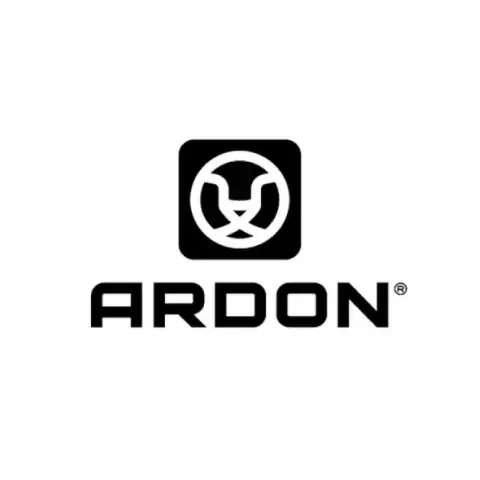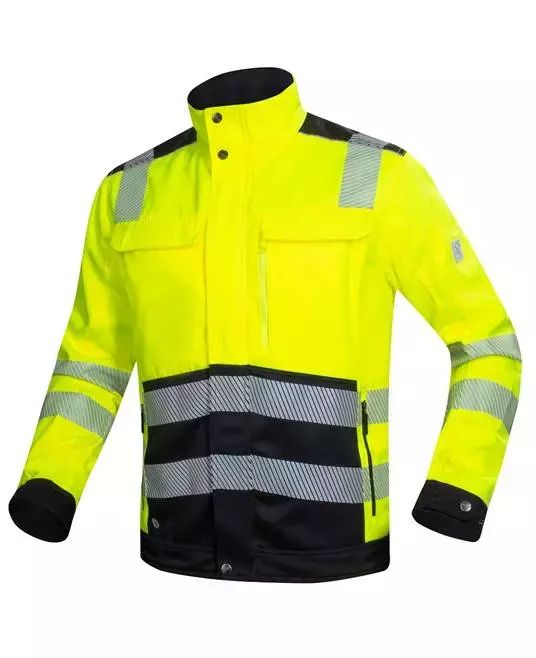Ardon Safety Signal Jacket Yellow And Black
Ardon Safety
visit storeProduct description
Product Features:
- Ergonomic slim cut for perfect fit
- Durable diagonal-type fabric with excellent mechanical properties
- High resistance to stretching and tearing
- Underarm ventilation
- Hydrophobic material finish
- Adjustable cuff and bottom width using snaps
Pockets:
- 2 open inner pockets
- 2 large chest pockets with Velcro flap
- 1 chest pocket with zipper
- 2 spacious lower zippered pockets
- Pen pocket on the left sleeve
Safety Features:
- Main zipper concealed by a Velcro and snap-fastened placket
- Segmented reflective strips:
— 2 on the front
— 2 on the back
— 2 on the sleeves
- Additional reflective strips on the shoulders
Technical Details:
- Material: 35% cotton, 65% polyester, diagonal weave, approx. 290 g/m²
- Standard: EN ISO 20471:2013+A1:2016
- Class 2: SIGNAL+ work jacket
- Class 3: SIGNAL+ work jacket; SIGNAL+ trousers (set)
The mechanism that secures the garment, affecting ease of use, security, and functionality. Different styles offer varying levels of quick access and durability.
Defines how sleeve ends are finished and secured at the wrist, affecting weather protection, comfort, and compatibility with work gloves.
Describes how the jacket sits on the body, affecting comfort, mobility, and layering options. Choose loose for maximum freedom, regular for balanced wear, or slim for a closer fit.
Defines the neck area design that affects weather protection, comfort, and compatibility with safety equipment like helmets and other PPE.
Indicates whether the jacket is designed for men's, women's, kids', or universal body types, ensuring proper fit, comfort, and range of motion.
Defines the jacket's structural design, such as hooded, parka, or bomber, affecting weather protection, visibility, and functionality for specific work environments.
Indicates total storage compartments on the garment, enabling organization of tools, devices, and essentials for efficient, hands-free work.
Defines the type, location, and closure of pockets on workwear, providing specialized storage for tools, devices, and essentials based on job requirements.
Measured in grams per square meter (g/m²), indicating fabric density and durability. Higher numbers mean heavier, more protective materials for demanding environments.
- Water Resistance
- High Visibility
- Machine Washable
Request a free sample
Test first and buy later. Visit any product page to request your free sample.
Standards and labels
EN 13688:2013 is a European standard that specifies the performance requirements for protective clothing. The standard includes requirements for safety, comfort, and durability, as well as tests for determining these properties. Protective clothing includes items like coveralls, aprons, and gloves that are worn to protect the wearer from hazards. Possible test results include resistance to chemicals, heat, abrasion and tearing, as well as breathability and comfort. The clothing can be tested under different conditions to check if it meets the standard's requirements.
Test results
Reflective Strip Area Grade 2The EU standard EN ISO 20471:2013, which outlines requirements for high-visibility clothing, specifically includes criteria for the reflective strip area needed for different grades of visibility and safety. A Grade 2 result identifies that reflective tape is 0.13 m2 and fluorescent material is 0.5 m2. This rating is determined through a combination of tests that assess how effectively the garment’s reflective strips can reflect light in low visibility or night conditions. For items rated Grade 2, this typically means the product has been assessed to provide a good level of visibility and reflectivity that is deemed suitable for environments with some level of light or medium-low risk areas. It assures that the wearer will be adequately noticed by others, particularly in scenarios where visibility is critical for safety, such as road work at night or in adverse weather conditions.
Reflective Strip Area Grade 3The EN ISO 20471:2013 standard specifies the requirements for high-visibility clothing, with a specific focus on the reflective strip area, a crucial element for ensuring visibility in low-light conditions. A test result achieving Grade 3 indicates the highest level of reflectivity performance in this standard, ensuring optimal visibility and safety for the wearer in various lighting conditions. In grade 3 products reflective tape is 0.20 m2 and fluorescent material is 0.8 m2.The test methodology involves assessing the amount and quality of retroreflective material on garments. This is quantified under precise conditions to ensure that the reflective strips meet stringent visibility requirements even from significant distances or in poor lighting conditions. Garments that meet Grade 3 requirements are suitable for use in high-risk environments where being seen by others is crucial for safety, such as road construction sites, airport ground operations, and other scenarios with high vehicular traffic or complex visual backgrounds.
CE Marking is a label that shows a product meets certain safety and environmental standards set by the European Union. To get the CE Marking, a company must test and certify their product meets these standards. CE Marking is required for many products sold in the EU, including electronics, machinery, toys and medical devices. It helps ensure that products are safe for consumers and the environment, and allows for easy trade within the EU.
PPE stands for "personal protective equipment." PPE Category 2 refers to equipment that is more complex, and has a higher level of risk. Examples of PPE Category 2 include safety helmets, ear protection, and fall arrest equipment. In Europe, PPE Category 2 must meet certain safety standards set by the European Union, which means that it must be designed and manufactured to protect the user without causing harm. Companies that make or sell PPE must prove that it meets these standards. They also must have a quality management system in place and have to be audited regularly by a notified body.
Textiles are materials made from fibers, such as cotton, wool, or polyester. In Europe, there are rules for how textiles should be made, sold, and labeled. These rules are set by the European Union. These rules ensure that textiles are safe and do not contain harmful chemicals, that they are labeled correctly and that the use of certain dangerous chemicals are banned. These rules are set to protect the health and safety of consumers and the environment. Companies that make or sell textiles in the EU must comply with these rules.
Ardon Safety delivery terms
Free delivery when you order more than 1 650,00 kr from Ardon Safety
Supplier shipping fee 60,00 kr
Brand minimum 1 400,00 kr
634,49 kr
Shipping fee is 60,00 kr for orders under 1 650,00 kr
Sold in units of one piece
Need larger quantities?
Other products you may like
Recently viewed
Need help?
Get help from our experts
Other products you may like
Similar products you may like
Recommended for you
Ardon Safety
Delivery time: 5 business days
Orders from 1 400,00 €
Supplier shipping fee 60,00 €
Free shipping on orders over 1 650,00 €



Find +150,000 products from hundreds of brands
Autonomous sourcing platform
The most efficient way to source and order supplies for your operations
Sourcing
Ordering
List products you’re looking for and we’ll find the best products and prices for you – all for free.
Need help?
Get help from our experts
